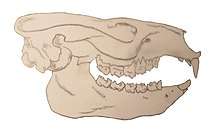Notioprogonia
Notioprogonia is a suborder of the extinct mammalian order Notoungulata and includes two families, Henricosborniidae and Notostylopidae.[2]
| Notioprogonia[1] | |
|---|---|
 | |
| Skull of Notostylops | |
| Scientific classification | |
| Kingdom: | |
| Phylum: | |
| Class: | |
| Order: | |
| Suborder: | †Notioprogonia |
| Families | |
Notioprogonia includes the most primitive notoungulates and Cifelli 1993 has argued that Notioprogonia is paraphyletic because it would include the ancestors of the remaining suborders.[3] Notioprogonia is not a natural group but an assemblage of primitive notoungulates; the two families assigned here simply do not clearly belong to any other clades.[4]
Description
Henricosborniids such as Henricosbornia and Othnielmarshia from the late Paleocene (Itaboraian-Casamayoran SALMA) have generalized, low-crowned teeth with the dental formula 3.1.4.33.1.4.3 and are dentally the most primitive notoungulates, most likely located near the origin of all other notoungulates. Simpsonotus, also from the late Paleocene and geologically the oldest notoungulate, provides us with the only known Henricoborniid skull. It lacks an epitympanic sinus and a tympanic crest, auditory specializations that are considered synapomorphic of notoungulates, which suggests that these features evolved within notoungulates. Simpsonotus' anterior dentition, on the other hand, is slightly odd and apparently derived, which suggest that it represents a divergent lineage.[4]
Notostylopids such as the Casamayoran Notostylops and Boreastylops are slightly more derived than henricoborniids. Their dentition make them superficially similar to early primate-like (non-South American) mammals such as Plesiadapis.[4]
Arctostylopidae, a family known from the northern hemisphere, was previously included in Notioprogonia, but their resemblance to notoungulates is now believed to be convergent.[4] Simpson 1934 included Arctostylopidae when he first described Notioprogonia, and explained:[5]
The Suborder Notioprogonia is, therefore, named and defined to solve the present problem. The creation of this fourth suborder makes the differentiation of the other three much easier and renders it possible to make an arrangement of all the adequately known notoungulates which is relatively free of anomalies and confusion. The suborder is largely, but not exclusively, defined on primitive and negative characters. This does not necessarily make the group less distinctive, even verbally, since it includes no strongly aberrant forms which need to be considered as exceptional within it and since the other groups include no adequately known forms which are readily confused with notioprogonians.
Classification
- †Family Henricosborniidae
- †Henricosbornia
- †Othnielmarshia
- †Peripantostylops
- †Postpithecus
- †Simpsonotus
- †Family Notostylopidae
- †Anastylops
- †Boreastylops
- †Edvardotrouessartia
- †Homalostylops
- †Notostylops
- †Otronia
- †Parastylops
- Incertae sedis
- †Satshatemnus
- †Seudenius
References
- McKenna & Bell 1997, pp. 455–456
- Notioprogonia in the Paleobiology Database. Retrieved April 2013.
- Cifelli 1993, pp. 195–216
- Rose 2006, pp. 229–30
- Simpson 1934, p. 15
Bibliography
- Cifelli, Richard L. (1993). Szalay, F. S.; Novacek, M. J.; McKenna, M. C. (eds.). The phylogeny of the native South American ungulates. Mammal Phylogeny. 2, Placentals. New York: Springer-Verlag. ISBN 0-387-97853-4.CS1 maint: ref=harv (link)
- McKenna, Malcolm C.; Bell, Susan K. (1997). Classification of Mammals Above the Species Level. New York: Columbia University Press. ISBN 0-231-11013-8.CS1 maint: ref=harv (link)
- Rose, Kenneth David (2006). The beginning of the age of mammals. Baltimore: JHU Press. ISBN 0801884721.CS1 maint: ref=harv (link)
- Simpson, George Gaylord (1934). "Provisional Classification of Extinct South American Hoofed Mammals" (PDF). American Museum Novitates. 750: 1–21. OCLC 44042034. Retrieved April 2013. Check date values in:
|accessdate=(help)CS1 maint: ref=harv (link)